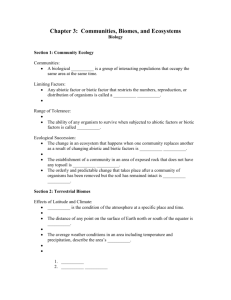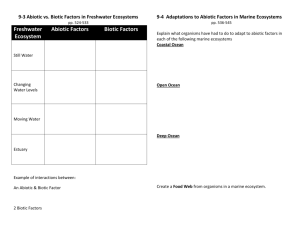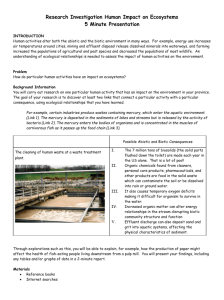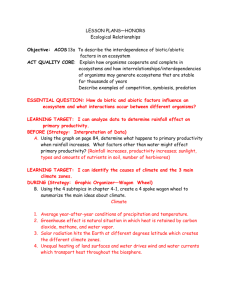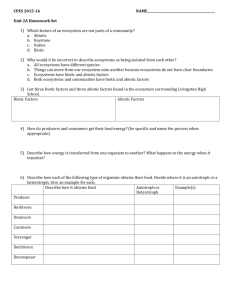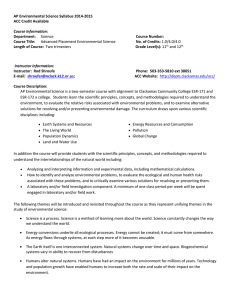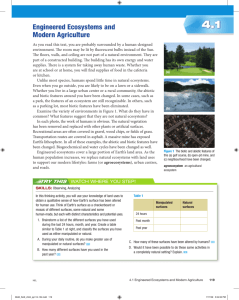TLI Unit Plan Overview
advertisement
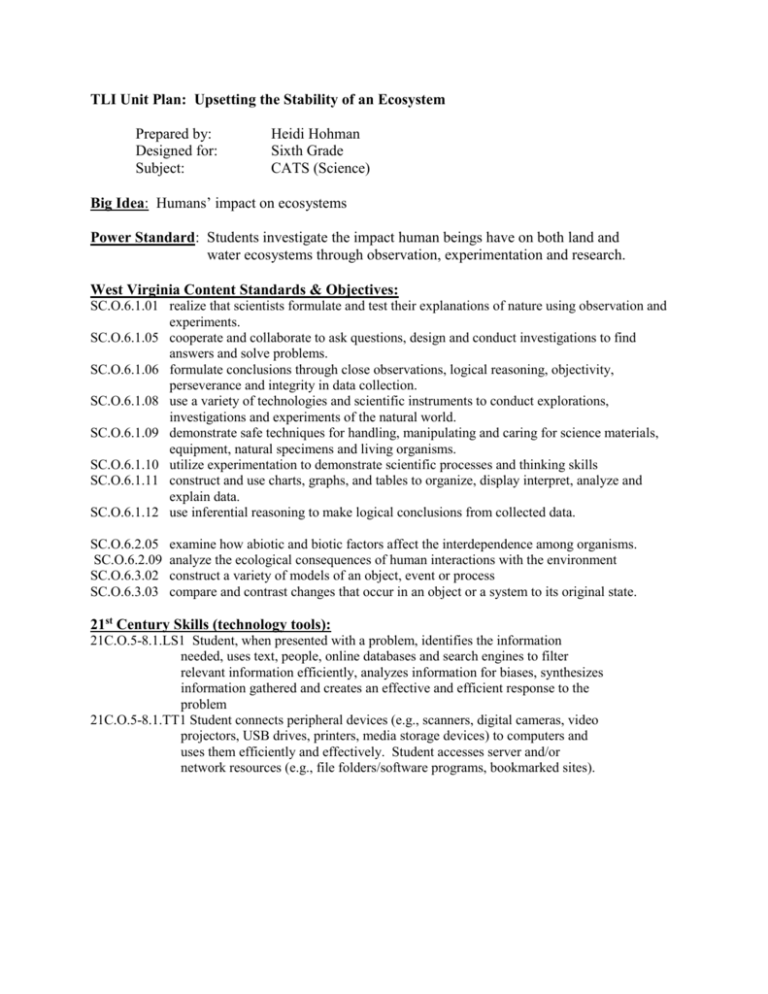
TLI Unit Plan: Upsetting the Stability of an Ecosystem Prepared by: Designed for: Subject: Heidi Hohman Sixth Grade CATS (Science) Big Idea: Humans’ impact on ecosystems Power Standard: Students investigate the impact human beings have on both land and water ecosystems through observation, experimentation and research. West Virginia Content Standards & Objectives: SC.O.6.1.01 realize that scientists formulate and test their explanations of nature using observation and experiments. SC.O.6.1.05 cooperate and collaborate to ask questions, design and conduct investigations to find answers and solve problems. SC.O.6.1.06 formulate conclusions through close observations, logical reasoning, objectivity, perseverance and integrity in data collection. SC.O.6.1.08 use a variety of technologies and scientific instruments to conduct explorations, investigations and experiments of the natural world. SC.O.6.1.09 demonstrate safe techniques for handling, manipulating and caring for science materials, equipment, natural specimens and living organisms. SC.O.6.1.10 utilize experimentation to demonstrate scientific processes and thinking skills SC.O.6.1.11 construct and use charts, graphs, and tables to organize, display interpret, analyze and explain data. SC.O.6.1.12 use inferential reasoning to make logical conclusions from collected data. SC.O.6.2.05 SC.O.6.2.09 SC.O.6.3.02 SC.O.6.3.03 examine how abiotic and biotic factors affect the interdependence among organisms. analyze the ecological consequences of human interactions with the environment construct a variety of models of an object, event or process compare and contrast changes that occur in an object or a system to its original state. 21st Century Skills (technology tools): 21C.O.5-8.1.LS1 Student, when presented with a problem, identifies the information needed, uses text, people, online databases and search engines to filter relevant information efficiently, analyzes information for biases, synthesizes information gathered and creates an effective and efficient response to the problem 21C.O.5-8.1.TT1 Student connects peripheral devices (e.g., scanners, digital cameras, video projectors, USB drives, printers, media storage devices) to computers and uses them efficiently and effectively. Student accesses server and/or network resources (e.g., file folders/software programs, bookmarked sites). Essential Questions: How do humans affect land and water ecosystems? What are some common pollutants and what are their sources? How do these pollutants affect the biotic factors, including humans, within an ecosystem? How do scientists conduct fair or unbiased experiments to uncover crucial information? What does the term “trade-off” mean and how does this term apply to people’s choices and the environment? Enduring Understandings: Human interaction with the environment changes the environment. Know (Students will know): how to ask a question, develop a hypothesis, and design an experiment to test his or her hypothesis. pollutants can and do harm both land and water ecosystems. humans must recognize different points of views of various stakeholders regarding environmental practices. Do (Students will): use a search engine to research a type of pollutant. utilizing a group-generated question, design an experiment that will simulate a type of pollution. conduct the experiment recording observations of the terrarium and aquarium noting the possible affects generated by the simulated pollutant. collect and record the data in a computer science journal. make connections between the simulation experiment and real world problems to create a mock interview. Teacher Background Information: This unit will be an extension of an STC Ecosystems unit in which students construct an ecocolumn comprised of a terrarium, a connector and an aquarium. Small groups of students use 2-liter bottles for the basis of the model, and observe the interdependent and dependent relationships between abiotic and biotic factors of the model. Multiple Instructional Strategies for Engaged Learning: Cooperative Learning Managing Technology including graphic organizer software Questioning Subject integration Hands-on activities Assessment/Rubric: Inspiration software concept maps (before and after Lesson 1) Computer science journal with daily entries of observations and predictions for the duration of the project Individual sketches, digital photos, and a student-selected sample observation Letter to the editor or poster Group presentation in the form of a newscast interview Accompanying rubrics Materials/Resources: Safety goggles Tap water Possible simulated pollutants like lemon juice, vinegar, powdered fertilizer, table salt Pipettes Labels 2-liter bottles with lids Hand-lenses pH paper and code student science journals, computers for word processing and flash drives Various cups, stirring sticks, paper towels, beakers Digital Camcorder Digital Camera(s) Access to the Internet and to Inspirations software Northern spotted owl Power Point Presentation Copies of rubrics and worksheets Books: Biggs, A., Daniel, L. Feather, R., Ortleb, E., Snyder, S., Zike, D. (2005). Glencoe science level red. Columbus,OH: The McGraw-Hill Companies, Inc. George, J. (1995). There’s an owl in the shower. New York: HarperCollins Publishers. National Science Resources Center. (1996). Ecosystems. Burlington, NC: Carolina Biological Supply Company. Zike, D. (2001). Dinah Zike’s big book of science middle school and high school. San Antonio, TX: Dinah-Might Adventures, LP. Websites: http://www.inspiration.com/download/pdf/InspirationAssessmentRubric.pdf Contact author: hhohman@acess.k12.wv.us


